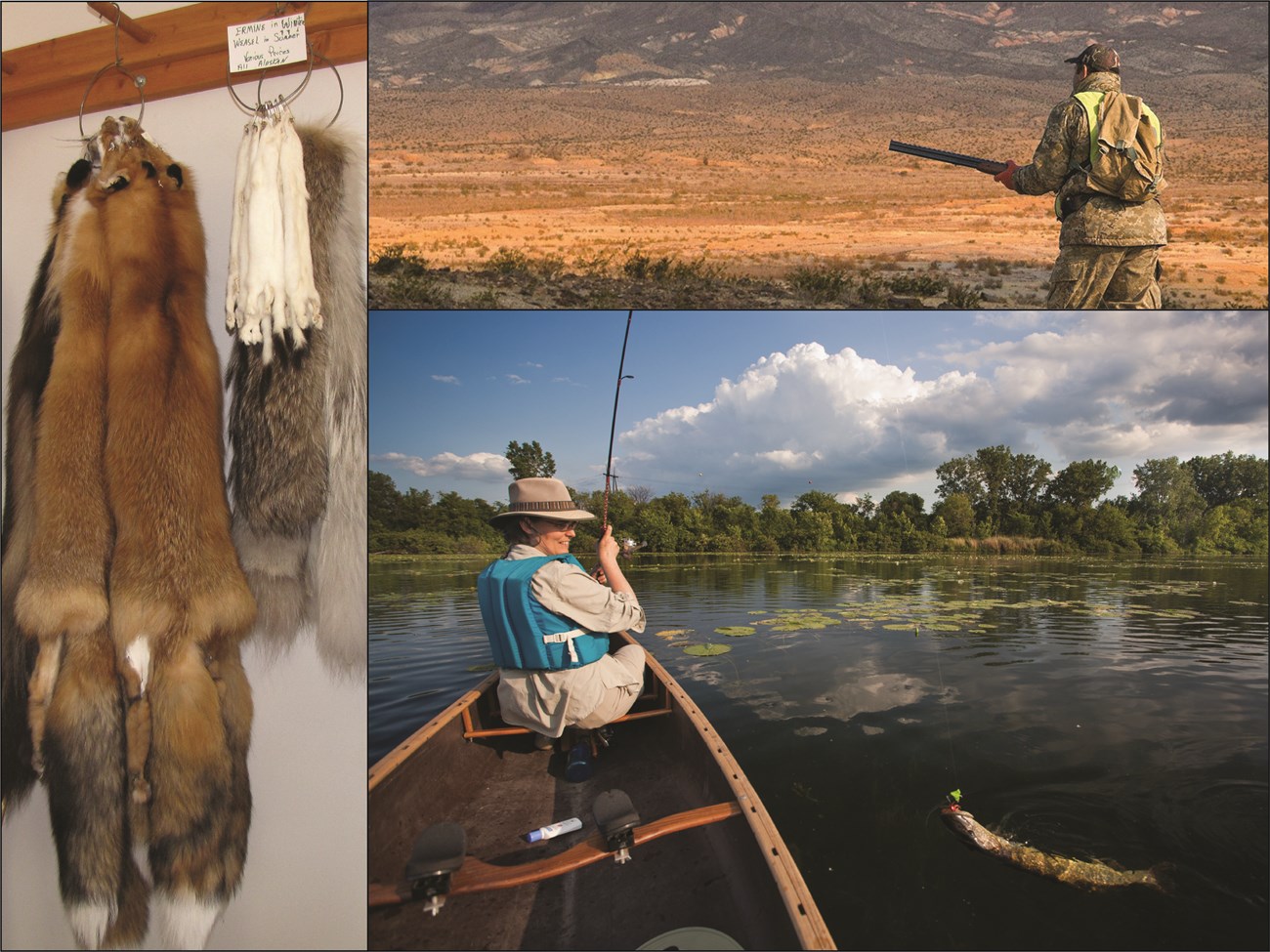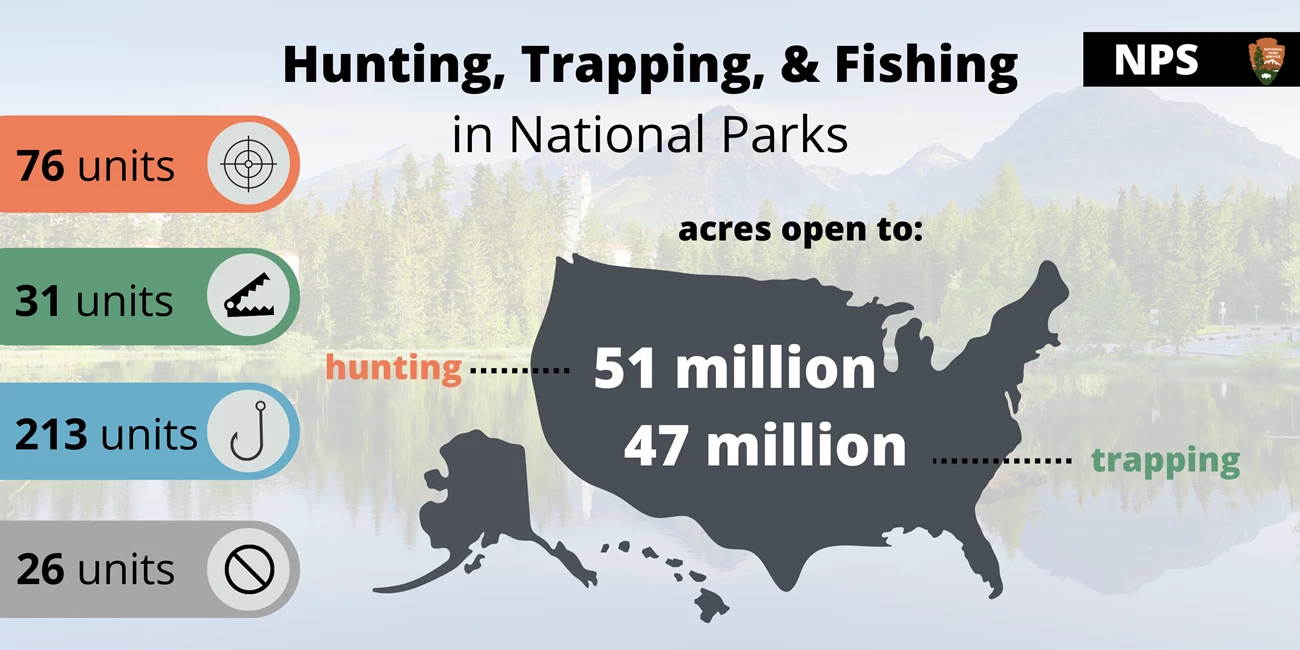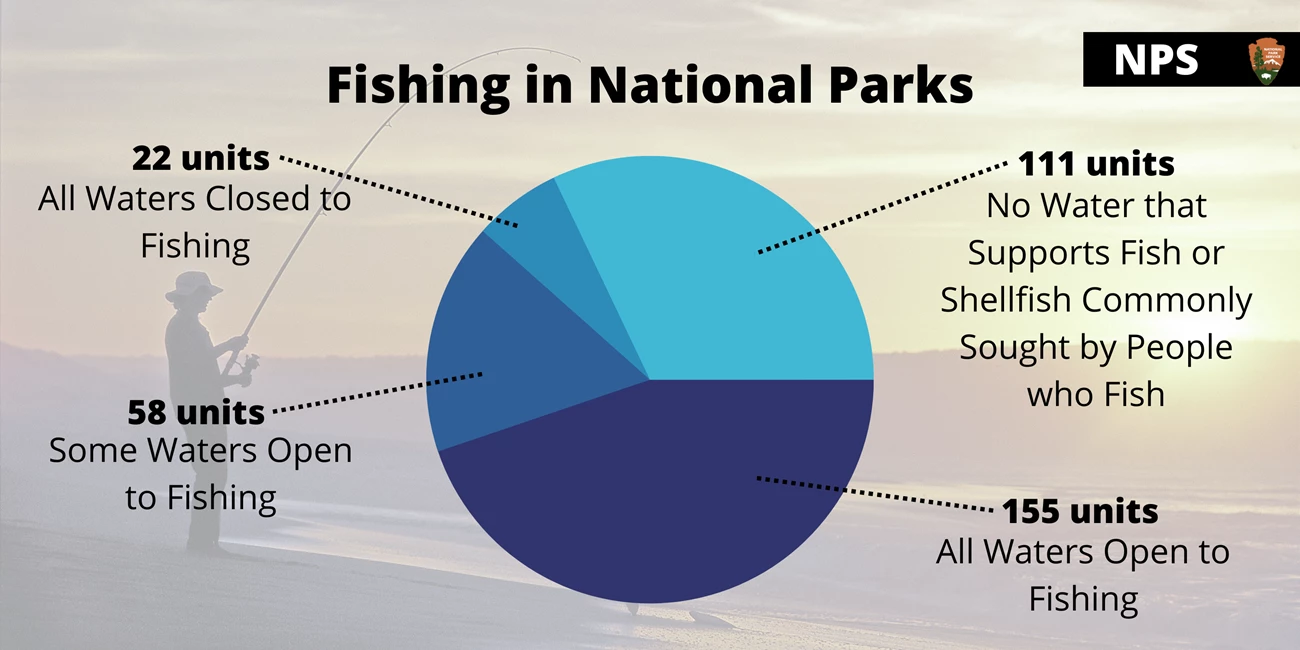Last updated: December 29, 2022
Article
Hunting, Fishing, Trapping Activities Across the National Park Service
The National Park Service (NPS) manages over 400 park units for the conservation of resources, including wildlife, for enjoyment by current and future generations. Enjoyment of these natural areas and their resources include management for hunting, trapping, and fishing where authorized by existing laws.

Where is hunting, trapping, and fishing authorized?
Hunting may occur in park units where it is either mandated or authorized as a discretionary activity in the park’s enabling legislation or other laws.
Similarly, trapping is allowed where mandated by Federal statute. If there is no specific legal designation, then, by Federal regulation, hunting or trapping is not allowed in park units. In contrast to hunting and trapping, fishing is allowed in NPS units unless it is specifically closed through park-specific regulations. Fishing regulations typically consist of NPS Servicewide regulations, which include adopted, non-conflicting regulations of the embodying state(s).
Hunting, Trapping, and Fishing in National Park Units
Hunting is authorized in 76 NPS units, trapping in 31 NPS units, and waters are open to fishing in 213 NPS units. Twenty-six of the responding units do not allow hunting, trapping, or fishing of any kind.
Across the NPS, approximately 51 million acres are open to hunting (43 million acres in Alaska, 8 million in the contiguous states) and 47 million acres are open to trapping (43 million acres in Alaska, 4 million in the contiguous states), which is over 60% of the total NPS managed lands.

NPS
Hunting is allowed in 76 units
Trapping is allowed in 31 units
Fishing is allowed in 213 units
None of these activities are allowed in 26 units.
51 million acres are open to hunting.
47 million acres are open to trapping.
Hunting
Across NPS units, approximately 51,097,000 acres are open to hunting; 43,331,000 acres are open in Alaska and 7,766,000 open in the contiguous 48 states. The total acres that are open to hunting represent about 60% of the total acres of NPS managed lands.
Across all units where hunting is allowed, 66 have recreational hunting, 17 units have subsistence hunting, and one has tribal hunting. Ten units have both recreational and subsistence hunting.
Find Hunting Opportunities in Parks
Check out this list of parks that may allow hunting. Be sure to check park websites for more information about regulations and policies. Always remember to recreate safely and responsibly.
Trapping
In total, approximately 47,556,000 acres are open to trapping nation-wide; 43,274,000 acres are open in Alaska and 4,282,000 are open in the lower 48 states. The total acres open to trapping represent about 56% of the total acres of NPS managed lands.
Trapping is allowed in 31 NPS units. In addition, 18 units reported subsistence trapping. In eight Alaska parks, only subsistence trapping is allowed.
Find Trapping Opportunities in Parks
Find a park and check the park website to see if trapping is alllowed and get more information about regulations and policies. Always remember to recreate safely and responsibly.
Fishing
In contrast to hunting and trapping that must be specifically allowed, fishing in NPS units is allowed unless it is specifically closed through park-specific regulations. Fishing regulations typically consist of NPS servicewide regulations, which include adopted, non-conflicting regulations of the adjacent state.
In total there are 213 units that report that fishing or shellfishing activities occur, of which 155 have all waters open to fishing and 58 units have some areas closed to fishing or shellfishing. Further, 22 units have all waters closed to fishing and shellfishing, and 111 do not include waters that support fish or shellfish species that are commonly sought by people who fish. Parks that have water, but no fishing may not allow fishing for a variety of reasons including closures for human safety, fish species conservation, absence of sportfish in park waters, or degraded aquatic habitat that does not support fish.

NPS
Background image: a person in a hat fishing the shoreline at sunset
Pie chart graph:
| Fishing Designation | Units/Subunits |
| All Waters Open to Fishing | 155 |
| Some Waters Open to Fishing | 58 |
| All Waters Closed to Fishing | 22 |
| No Water that Support Fish or Shellfish Commonly Sought by People who Fish | 111 |
Across all units where fishing occurs, 213 units have reported recreational fishing, 50 reported subsistence fishing, 13 reported tribal fishing, and 30 reported commercial fishing.
Find Fishing Opportunities in Parks
Explore the map below to find NPS units that allow fishing. Be sure to check park websites for more information about regulations and policies. Always remember to practice responsible fishing.
Types of hunting allowed in responding park units
| Park Unit | Recreational | Subsistence | Tribal |
| Alagnak Wild River | Yes | Yes | No |
| Amistad National Recreational Area | Yes | No | No |
| Aniakchak National Preserve | No | Yes | No |
| Apostle Islands National Lakeshore | Yes | No | No |
| Assateague Island National Seashore | Yes | No | No |
| Badlands National Park - portion of area | No | No | Yes |
| Bering Land Bridge National Preserve | Yes | Yes | No |
| Bighorn Canyon National Recreation Area | Yes | No | No |
| Big Cypress National Preserve | Yes | No | No |
| Big South Fork National River & Recreation Area | Yes | No | No |
| Big Thicket National Preserve | Yes | No | No |
| Bluestone National Scenic River | Yes | No | No |
| Buffalo National River | Yes | No | No |
| Cape Hatteras National Seashore | Yes | Yes | No |
| Cape Krusenstern National Monument | No | Yes | No |
| Cape Lookout National Seashore | Yes | No | No |
| Canaveral National Seashore | Yes | No | No |
| Chicksaw National Recreation Area | Yes | No | No |
| City of Rocks National Reserve | Yes | No | No |
| Craters of the Moon National Preserve | Yes | No | No |
| Curecanti National Recreation Area | Yes | No | No |
| Cumberland Island National Seashore | Yes | No | No |
| Denali National Preserve | No | Yes | No |
| Delaware Water Gap National Recreation Area | Yes | No | No |
| Fire Island National Seashore | Yes | No | No |
| Gates of the Arctic National Park & Preserve 1 | No | Yes | No |
| Gauley River National Recreation Area | Yes | No | No |
| Gateway National Recreation Area | Yes | No | No |
| Glacier Bay National Preserve | Yes | Yes | No |
| Glen Canyon National Recreation Area | Yes | No | No |
| Great Egg Harbor River | Yes | No | No |
| Great Sand Dunes National Preserve | Yes | No | No |
| Gulf Islands National Seashore | Yes | No | No |
| Hagerman Fossil Beds National Monument | Yes | No | No |
| Jean Lafitte National Historical Park & Preserve | Yes | No | No |
| John D Rockefeller Jr Memorial Parkway | Yes | No | No |
| Kalaupapa National Historical Park a | Yes | No | No |
| Katahdin Woods and Waters National Monument | Yes | No | No |
| Katmai National Preserve | Yes | Yes | No |
| Lake Chelan National Recreation Area | No | Yes | No |
| Kobuk Valley National Park | No | Yes | No |
| Lake Clark National Park & Preserve | Yes | Yes | No |
| Lake Mead National Recreation Area | Yes | No | No |
| New River Gorge National River | Yes | No | No |
| Niobrara National Scenic River | Yes | No | No |
| Noatak National Preserve | Yes | Yes | No |
| Obed Wild & Scenic River | Yes | No | No |
| Oregon Caves National Preserve | Yes | No | No |
| Ozark National Scenic Riverway | Yes | No | No |
| Padre Island National Seashore | Yes | No | No |
| Parashant National Monument | Yes | No | No |
| Pictured Rocks National Lakeshore | Yes | No | No |
| Rio Grande Wild & Scenic River | Yes | No | No |
| Ross Lake National Recreation Area | Yes | No | No |
| Saint Croix National Scenic Riverway | Yes | No | No |
| Sleeping Bear Dunes National Lakeshore | Yes | No | No |
| Timucuan Ecological & Historic Preserve | Yes | No | No |
| Upper Delaware Scenic & Recreational River | Yes | No | No |
| Valles Caldera National Preserve | Yes | No | No |
| Whiskeytown National Recreation Area | Yes | No | No |
| Wrangell - St Elias National Park & Preserve | No | Yes | No |
| Yukon - Charley Rivers National Preserve | Yes | No | No |
b No hunting is allowed on the small portion of the Mississippi River and Recreation Area owned by NPS due to human safety conerns on the lands withing the administrative boundary that are not owned by NPS.
_________________
1 National preserves are areas having characteristics associated with national parks, but in which Congress has permitted continued public hunting, while it is not allowed within the defined boundaries of national parks. Subsistence hunting, however, may be allowed within certian national park boundaries.
List of "may hunt" park units and the type of hunting allowed at each
| Park Unit | Hunt a | Not Occuring | Recreational | Subsistence | Tribal |
| Cape Cod National Seashore | Yes | No | Yes | No | No |
| Lake Roosevelt National Recreation Area | Yes | No | Yes | No | No |
| Tallgrass Prairie National Reserve | No | Yes | No | No | No |
| Point Reyes National Seashore |
List of units where trapping is allowed and the type of trapping at each
| Unit | Recreational | Subsistence |
| Alagnak Wild River | Yes | Yes |
| Aniakchak National Preserve | Yes | Yes |
| Apostle Islands National Lakeshore | Yes | No |
| Bering Land Bridge National Preserve | Yes | Yes |
| Big South Fork National River & Recreation Area | Yes | No |
| Big Thicket National Preserve | Yes | No |
| Bluestone National Scenic River | Yes | No |
| Canaveral National Seashore | Yes | No |
| Cumberland Island National Seashore | Yes | No |
| Curecanti National Recreation Area | Yes | No |
| Denali National Preserve | Yes | Yes |
| Gates of the Arctic National Preserve | Yes | Yes |
| Gauley National Recreation Area | Yes | No |
| Gateway National Recreation Area | Yes | No |
| Great Egg Harbor River | Yes | No |
| Great Sand Dunes National Preserve | Yes | No |
| Jean Lafitte National Historical Park and Preserve | Yes | No |
| Kalaupapa National Historical Park | Yes | No |
| Katmai National Preserve | Yes | Yes |
| Lake Clark National Preserve | Yes | Yes |
| Lake Mead National Recreation Area | Yes | No |
| Little River Canyon National Preserve | Yes | Yes |
| Mojave National Preserve | Yes | No |
| Niobrara National Scenic River | Yes | No |
| Noatak National Preserve | Yes | Yes |
| Ozark National Scenic Riverways | Yes | No |
| Parashant National Monumnet (jointy managed by NPS/BLM) | Yes | No |
| Rio Grande Wild & Scenic River | Yes | No |
| Upper Delaware Scenic & Recreational River | Yes | No |
| Wrangell - St Elias National Preserve | Yes | Yes |
| Yukon - Charley Rivers National Preserve | Yes | Yes |
Number of units that have all waters open to fishing, some water closed to fishing, all waters closed to fishing, and no water that supports fish or shellfish species that are commonly targeted by people who fish.
| Fishing Designation | Units/Subunits |
| All Waters Open to Fishing | 155 |
| Some Waters Closed to Fishing | 58 |
| All Waters Closed to Fishing | 22 |
| No Water that Supports Fish or Shellfish Commonly Sought by People who Fish | 111 |
